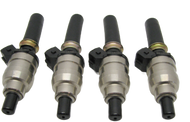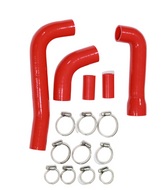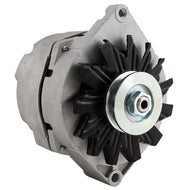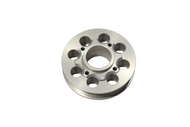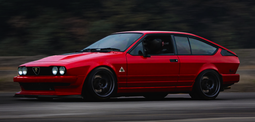This photo is an Alfa Romeo postcard. This is a 1986 GTV6. It can be recognized as a post 83' car because of its larger front Alfa Romeo emblem, low side moldings, and wheels that were available on the GTV6 in 1986 only. The 86' cars are considered to be the best and most desirable GTV6s. However, the truth is they are all pretty good and the early cars have some advantages. The later cars have a few more advantages, but not enough to justify a large difference in price. Don't pass up a really great 82' for a mediocre 86'.
The Alfa Romeo GTV6 was produced from 1981 through 1986. There are rumors of some 1980 cars and some 1987 cars but I doubt you will ever see one, at least not in the U.S. The differences from year to year are fairly minor but I will try to touch on the bigger ones.
The GTV6 was arguably the hottest and best sport coupe of the early 80's. It features a 2.5 liter V6, four wheel disc brakes-inboard at the rear, and a rear mounted transaxle to give near perfect weight distribution. It has a great racing history, having won just about every championship it was eligible for. Usually cars with a great racing history and low production numbers become quite valuable. Somehow though it seems these cars have been largely forgotten and thus are quite inexpensive. If you want a fun collectible car this just might be not only the best buy out there, but also the best car!
Almost all GTV6's left the factory with Alfa's fantastic 2.5 liter V6. A few cars sold in the South African market had a 3.0 liter engine of the same design, and in the U.S. a twin turbo version of the 2.5 was available in later years with about 50% more power but it is ultra rare. This engine has two cams, five main bearings, a wet sleeve design, hemi heads, Bosch fuel injection and about the strongest crankshaft I have ever seen this side of an American V8. This engine has 154 horsepower. That may not sound like a lot of power now but compared to it's competitors of the day it was a monster! The Porsche 924, Mazda RX7, and BMW 320i all had about 100 horsepower, the 1982 Z28 and Trans Am had 145 horsepower, the Datsun 280ZX, which was considered the really hot car in the early 80's, had 140 horsepower. The Alfa's engine enabled it to outrun nearly all of its competitors and reach a top speed of 130 mph. This was at a time when the most common police car, the Dodge St. Regis, has a top speed of 90mph and took over two miles of road to reach it. The Alfa is not made for the stoplight grand prix, but it's actually pretty good at it. One magazine got a 0-60 mph time of 7.6! I think that was a really cold day with a really great driver and maybe even a cheater car. However the GTV6 is certainly capable of low to mid eights.
The Alfa V6 uses one camshaft in each head. It actuates the intake valves directly and the exhaust valves via a very short pushrod and rocker arrangement. This arrangement is very clever because it allows very high RPM without the danger of a thrown or bent pushrod but with the bearing drag of only one cam per head. Only a few engines in history have used this short pushrod trick. One such engine was a Mercedes sponsored Indy Car engine that won the Indy 500 a few years ago. In stock form the engine is in mild tune with fairly low compression and mild cams plus the engine is very strong with a great crankshaft and a very stiff block and heads. This means its power can be increased easily and without fear of destroying the engine. Alfa actually provides instructions for boosting its power output to over 200 hp. With turbo or supercharging its power levels can reach incredible heights. 300, 400 and even 500 horsepower can be attained.
Here is a brand new GTV6 2.5 liter V6.
The GTV6's suspension is second to none. The rear suspension is Alfa's De Dion type which is quite unusual. Only a handful of cars have ever used this type of suspension. Examples include several Grand Prix Racing cars, at least one world championship wining Formula 1 car, and some Ferraris & Lancias. The Alfa De Dion setup is basically a big triangle with wheels mounted at two corners and the front of the triangle mounted to the chassis via a really large bushing. There are many advantages of this setup. First of all: suspension travel has no effect on rear wheel alignment, none, zero. Just about every other type of rear suspension has a geometric effect when it moves causing the wheels have camber changes and/or toe changes during suspension compression and rebound. With this setup the rear wheels never loose their relationship with the road no matter what the road or driver does (well, short of driving off a cliff). Since there are no geometric changes associated with suspension travel, the designers of the GTV6 were free to include as much suspension travel as they could fit in the space available. Thus, the GTV6 has more rear suspension travel than any other car I know of and it rides well because the designers did not need to use really stiff springs to keep the rear wheels pointed the right way during cornering. Another often forgotten advantage of the Alfa De Dion set up is that the wheels provide thrust to the center of the car. Remember, all cars transmit power from an engine to a transmission then to the drive wheels and finally through the suspension to the car. It's the suspension that the drive wheels push or pull on. In any other type of suspension the power is delivered asymmetrically to the car. In other words: when one wheel bites better than the other during acceleration, normal cars apply more power to one side than the other. That's why some cars tend to get a little unsettled when you hit the gas at low speed or coming out of a corner. This is not a factor in the GTV6. No matter which wheel is biting, all the power is transmitted to the center of the car and it will go straight as long as the wheels are not slipping.
To further exploit the De Dion's characteristics, Alfa located the rear shocks upside down and the rear disc brakes inboard at the transaxle. This plus the use of alloy wheels reduces the un-sprung weight to a minimum thus allowing the rear suspension to react to inputs from the driver or irregularities in the road very quickly.
The Alfa transaxle is located within the perimeter of the De Dion triangle. This rear mounted clutch and transaxle provide excellent weight distribution, officially it's 50/50! The list of cars using front engines and rear mounted transaxles reads like a who's who of performance car history. This list includes the Porsche 928, Ferrari's current top production car - the 550/575, and the latest generation of Corvette. Ferrari's top Formula One driver claims this is the best setup for a road car, even superior to mid engine.
The front suspension of the GTV6 is a variation of the classic twin A-frame design common on serious performance cars. Just about every great performance car has used this type of front suspension, but Alfa made theirs a little better than most by using forged lower A-arms riding on bearings, not bushings, and a threaded rod to provide adjustable castor. Camber adjustment is made using shims.
Another factory photo showing a brand new rear suspension, transaxle inboard rear brakes, and clutch housing.
Ok Ok, enough technical stuff, so how well did all this fancy engineering really work you might ask. Well according the automotive press at the time it worked very, very well. In a Road and Track comparison test the non-turbo GTV6 came out way ahead of the Turbo 280ZX and Porsche 924 Turbo. They didn't even factor in the GTV6's advantage of having a usable back seat, something the other two cars did not have. Motor Manual said when comparing the 83' GTV6 to the Mitsubishi Starion Turbo, Datsun 280ZX, Mazda RX7, BMW 323i, and Honda Prelude Si that all may be fine cars but "none have the breeding, prestige or balls-out performance of the GTV6." What Car? magazine compared the 82' GTV6 to the Toyota Supra and Mitsubishi Sapporo Turbo. They were too wishy washy to declare any one car the winner but the Alfa out ran the other cars and got better fuel economy while doing it.
Only one car fared well against the GTV6 in comparison tests and that was the European market only Ford Capri 2.8i which was built in Germany but tuned by Ford's Special Vehicle Engineering operation in England. The British magazines tend to favor their home vehicles and the Capri 2.8i was their baby so in most subjective tests they said it was a better car. On paper both cars had identical performance - the Alfa achieved its through design, the Ford by using simple car just souped up to a higher state of tune by Ford's SVE dept.
Someone at Car magazine, another British publication decided to test the two cars together at Castle Combe which is apparently some famous race track in England. Although the numbers suggested they would be close the Alfa easily defeated the Capri on the racetrack. They still ended the article saying the Capri was the better car for entirely subjective reasons.
There were three points of criticism of the GTV6 common in the automotive press which I feel I should address. First there was a lot of complaining about body roll. The car always seemed to get around the corners faster than its competitors, it just leaned a lot doing it and the journalists did not like that. What they apparently did not understand is that the Alfa's suspension allows the wheels to remain upright and in good contact with the road even with a lot of body lean. Lesser cars don't have suspensions that allow that so they limit a car's body roll by stiffening the suspension and sacrificing ride quality. Alfa did not need to do that.
The second point had to do with driving position. Most journalists felt that the steering wheel is located too far away from the driver if the seat is adjusted to be the proper distance from the pedals. Again, they don't really understand the car. In the U.S. most drivers are taught to hold the steering wheel at the 10 and 2 o'clock position. In Italy they hold the wheel at the 4 and 8 o'clock position as did most Formula 1 drivers at the time (they now have a different type of steering wheel in most F1 cars that can only be held at 3 and 9). Grab the wheel at 4 and 8 and it will feel like it's at the right distance. Grab it at 10 and 2 and it will be too far because of the way the steering wheel tilts. Drive the car like an Italian and you will feel very comfortable in a short time. As a point of interest - Alfa did move the steering wheel closer to the driver in the GTV6's later years but no one seemed to notice. It still was not close enough for the 10 and 2 grab anyway.
The third point of criticism involved the shift linkage. This is actually a valid criticism until Alfa improved the linkage in mid 85 but the early linkage can be greatly improved with a couple hours work and about five dollars. There is a bushing in the shift linkage made out of plastic. It wears out quickly causing the shift linkage to become sloppy. It's easy to replace with a metal bushing and that will make the linkage just fine. They also complained about the Alfa's poor transmission synchros and this is a fair criticism, but with proper shifting technique the synchros will last a long long time, over 100,000 miles. If you think you know how to shift, and maybe you do, but you should read my article on double clutching anyway.
If you are considering a special interest car, the GTV6 is one of the best. You can find drivable early examples for as little as $2,000, and $4,000 buys you a great one and 7,000 a near perfect car. If you are a big spender you could buy one of the very rare Callaway Twin Turbo models and enjoy its 230 hp and six second 0-60 times for about $8,000 for one that need some help up to about $15,000 for a great one. EDIT: prices are much higher now! Click here for sales history on bringatrailer.com
Some say that the later GTV6's are much better than the early ones, that is not really true. They are all quite similar. All years have the exact same bodies. Side molding, emblems and available colors changed but the cars all look the same. The 82' and 83' cars have fairly tall gearing, not as good at the race track or when zooming away from a stoplight but superior on long highway trips. The 82' and 83' cars are about a half second slower 0-60 mph but are quieter at highway speeds and use less fuel. A well tuned 82' or 83' car will get 32 mpg at 70 mph with no problem! The other years will only get about 28 mpg at that speed and can get just over 30 mpg if driven at 55 mph. The 1984 and later cars with Tropic Air have no fresh air vents as they were replaced with a more powerful air-conditioning system. The air conditioning in early cars can be improved to be as good as the Tropic Air systems so that's not really an advantage. The Tropic Air system also took up the space occupied by a little shelf on the earlier cars. That shelf is nice to have for holding CDs and stuff. The 81' through 83' cars have their front ends up a little higher than the 84' through 86' cars, however they are all too high and any GTV6 should be lowered to the European front ride height. Lowering is accomplished via an adjustment involving the torsion bars, no new parts are needed. Instructions for lowering the torsion bars are available here. The mid 85's and all the 86's have an improved shift linkage, known as iso-static shift linkage, but it's only a little better that a modified early linkage. The later linkage also has a lot more parts to wear out, it's quite complex and it makes changing the clutch a real pain, instead of the relatively easy job it is in the early cars.
In short the later cars have some minor advantages but they are not enough to justify passing up a good early example.
This GTV6 is an 83' it is can be recognized as a pre 84' car because it has the smaller front emblem. This particular car is quite fast with an estimated 165hp. It's also lowered and has polyurethane bushings throughout its suspension. The intake louvers and hood center are normally dark Grey but the owner of this one has decided to brighten things up a bit. This is the same year and color combination as the GTV6 James Bond used to outrun the BMW cop cars and save Europe from a nuclear disaster.
Here is a factory photo of an 85' car. It has wheels that were available in 85' only. This car appears to be a European spec car because it's front end is not up at the U.S. ride height. If you have a GTV6 the front end should be lowered to match the car in this photo. White GTV6s are very rare, it's too bad since I think they look nice.
ALL GTV6's came with high quality alloy wheels. This is a Campagnolo wheel like the ones all GTV6's came with until 1985. This type of wheel was sometimes colored black or white from the factory but most look pretty much like this one. It is the strongest and best of the stock GTV6 wheels. The 1985 car came with nice looking wheels made by Speedline, but they are an odd size. The 1985 wheels have a 365mm diameter instead of the 15" diameter all the others have. This makes it very difficult and expensive to buy tires for them and impossible to buy modern tires. Most owners of 85' cars change to the 15" wheels from other years. The 1986 car had 15" wheels also made by Speedline but they are not quite as high quality as the original Campagnolos.

Please visit our other pages!



